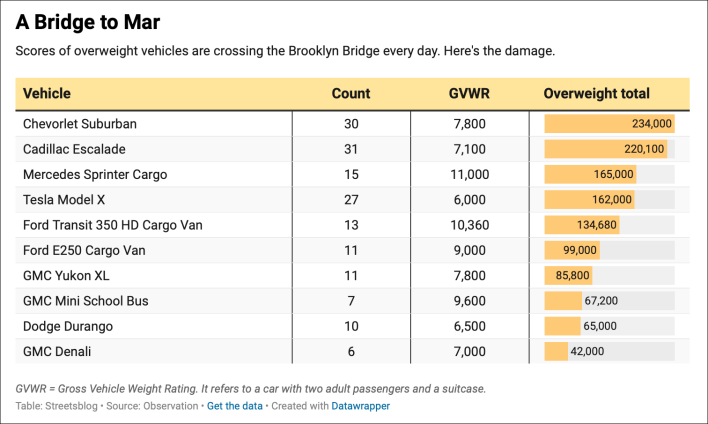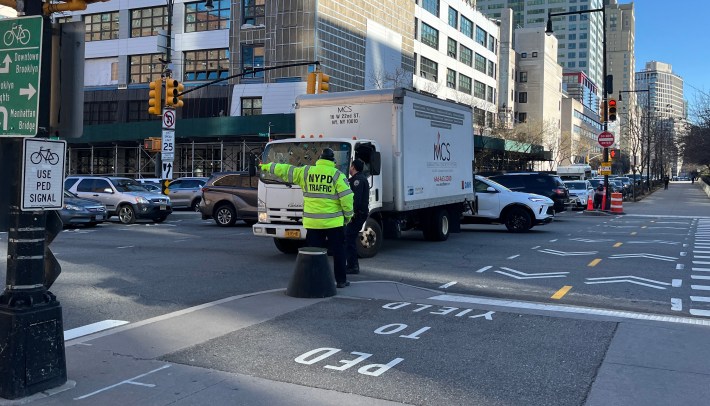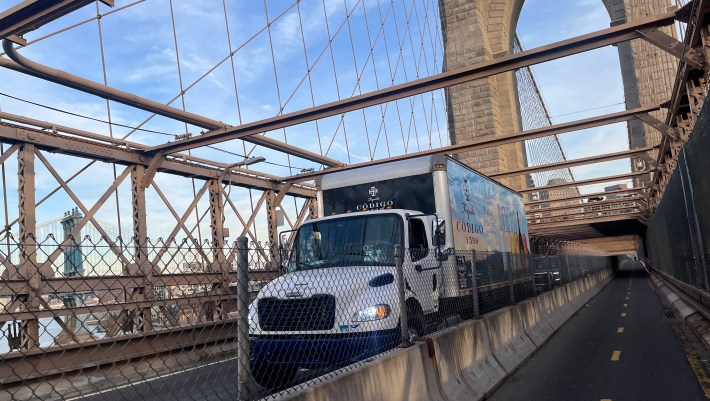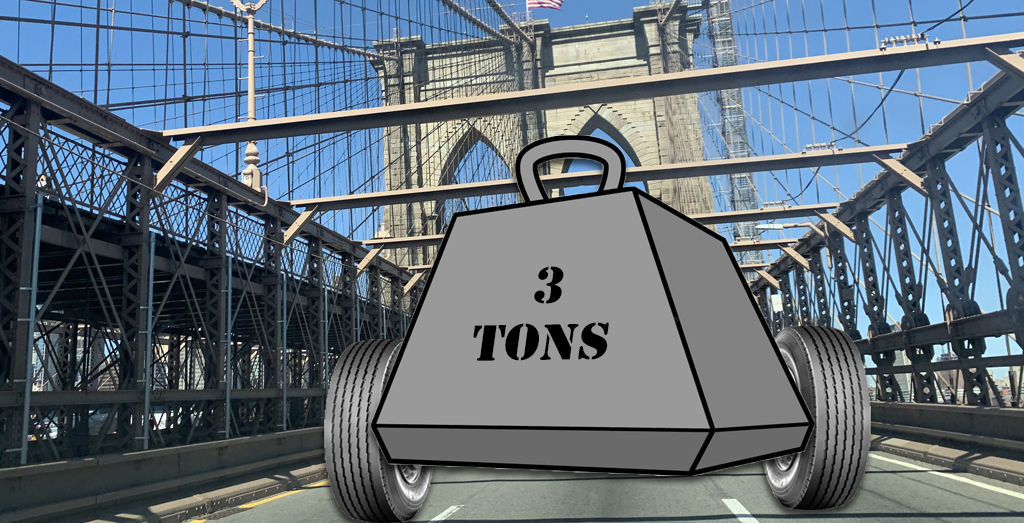The weight is on.
Vehicles that tip the scales at more than three tons are barred from the Brooklyn Bridge to reduce wear on the historic span. But thanks to America’s obsession with big vehicles — encouraged by the federal tax code, no less — scores of regular cars now routinely cross that 6,000-pound threshold as the city does virtually nothing to stop them.
During the course of a single weekday afternoon hour last week, Streetsblog spotted 103 likely overweight vehicles zipping towards Manhattan across the span — cars, trucks, and school buses with weight ratings well over the three-ton limit. During a similar observation period, there were 157 such road hogs headed to Brooklyn.

Of those 260 trucks, 52 had plates indicating they were commercial vehicles, which are also banned on the 141-year-old landmark. Also among the wrecking crew was overweight city work trucks and 23,000-pound school buses.
And on any given day, Mayor Adams is among the scofflaws. His ride of a choice, a 2023 Chevrolet Suburban High Country, has a curb weight of more than 5,800 pounds — but with its two passengers, which it always contains whenever the mayor is being driven somewhere — it's illegal. It's also in line with the national trend of heavier vehicles. (City Hall did not respond to repeated requests for explanation.)
Cause for alarm?
It's not as if the Brooklyn Bridge is going to collapse. Thanks to an original design meant to carry trains, the bridge can hold something like 17,000 tons at any given time, so even if every vehicle traversing the bridge was overweight, it would only add a few scores of tonnage.
Then again, the bridge, which would cost $2.3 billion to replace, has never earned a rating above “fair,” according to DOT reports dating to 2000.
And the city has said in the past that it is worried about the structural integrity of the span. In 2017, the Department of Transportation said it needed to study the bridge's aging cables before it could even consider widening what was then a shared pedestrian and bike path that sits on a promenade that was between all six lanes of heavy car traffic.
Some relief for the bridge came in the form of the removal of one lane for cars to create a two-way bike path on the westbound roadway. But like many of us as we age, the bridge will likely put back on that weight in the coming years because cars are simply getting heavier.
Currently, there are roughly 100 cars and trucks that exceed 6,000 pounds when carrying two passengers. That weight figure is important because the IRS allows such mega-cars to be deducted as a business expense in the year they're put into service instead of depreciated slowly over time. Many car enthusiasts gush online about the benefit, which is worth tens of thousands of dollars and is partly responsible for the increase in sales for SUVs and light trucks.

And that popularity is already causing damage to our city. In a high-profile case, a garage in Lower Manhattan collapsed under the weight of mega-cars — and the New York Times reported that many garages are in danger of destruction.
And just below most people's scrutiny is the day-to-day damage caused by heavy vehicles: Injuries from crashes involving supersized cars increased in New York City by 91 percent and fatalities were up 75 percent between 2016 and 2019, according to a report. Other studies show that for every 1,000-pound increase in vehicle weight, there is a 46-percent increase in motorist fatalities.
A 6,000-pound vehicle causes more than five times as much road damage as a 4,000-pound sedan. A GMC Hummer EV, which weighs 9,063 pounds, will cause 116 times as much road damage as a Honda Civic, weighing 2,762 pounds.
One simple way to put the bridge on a diet would be to add a protected bike lane to the eastbound side of the bridge, switching one lane from heavy truck traffic to light bike traffic. DOT declined to comment.
Another solution would be to set up cameras and weight sensors to flag and fine overweight vehicles, much as the city has done to discourage overweight truck traffic on the crumbling section of the Brooklyn-Queens Expressway. Tickets on that highway reach $650, and the DOT says they are showing early promise (Streetsblog filed a freedom of information request to learn more).
“I’m certain cameras and sensors would work,” said Michael Cata, a DUMBO-based tech consultant who has tracked oversize vehicle incursions on the bridge. "These are not complicated technologies, and it would probably pay for itself overnight." (Sensors would require a new state law, which is not easy to get.)
Beat cops
In lieu of dedicated enforcement, the city has deployed an NYPD squad car at Tillary Street on the Brooklyn side. All day and all night, two officers man a post, but do very little to stem the flow of overweight traffic.
A police officer at the bridge entrance the other day said cops don’t bother with heavy SUVs like Chevy Suburbans, and only focus on obviously oversize trucks.
“It’s fine,” the officer said. “Is it a truck? It’s either a truck or it’s not a truck,” when asked about the heavy luxury SUVs heading over the bridge.
Every once in a while, an officer directs a truck driver to another span:

But other times, big trucks make it onto the old bridge:

The NYPD declined to comment. DOT said it is not worried.
“DOT closely monitors its nearly 800 bridges, including its crown jewel – the Brooklyn Bridge. The bridge is safe for all New Yorkers and visitors to enjoy,” said agency spokesperson Mona Bruno.
— Additional reporting by Gersh Kuntzman






